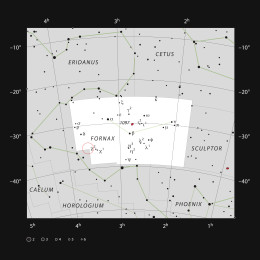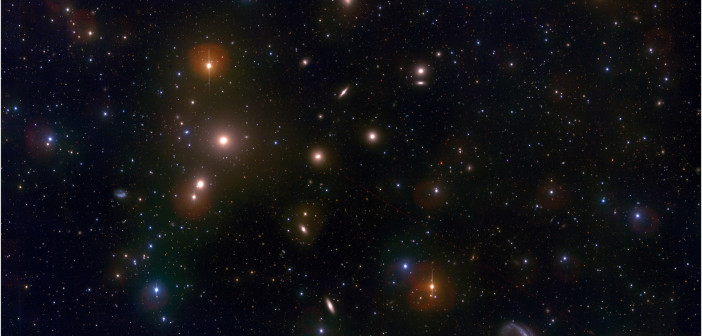Traditionally, dense cluster centers are cannibalistic environments, with larger galaxies stripping stars from smaller interlopers in minor mergers and dynamical harassment. A recent survey of the Fornax cluster, one example of such an environment, reveals how this cluster may have been built.
Clues in Halos

Context for the southern constellation Fornax (“the furnace”). The Fornax cluster is marked with a red circle. [ESO, IAU and Sky & Telescope]
The Fornax Deep Survey (FDS) is just such a campaign. FDS uses the European Southern Observatory’s VLT Survey Telescope to obtain deep photometry of the entire 26 square degrees of the Fornax cluster, a spectacular galaxy cluster located 65 million light-years away.
Central Observations
The FDS team plans to release the full results from the survey soon. For now, in an initial study led by Enrichetta Iodice (INAF’s Astronomical Observatory of Capodimonte, Italy), the team presents their first findings from the two square degrees around NGC 1399, a supergiant elliptical galaxy in the cluster center.
The two main results from this study are:
- The discovery of a faint stellar bridge between NGC 1399 and a nearby galaxy, NGC 1387.
- The characterization of NGC 1399’s light profile, which shows that the galaxy consists of two main components separated by a strong break. The bright central galaxy is likely composed of stars that formed in situ, whereas the exponential outer component is a stellar halo composed of stars likely captured from accretion events.
What do these points tell us about the history of the center of the Fornax cluster? These observations are indications that the Fornax cluster was built up by mergers and accretion events.
A Violent Past
The light profile the authors found is consistent with those of simulated galaxies whose halos were formed through the multiple accretion of progenitors. This suggests that the stellar halo of NGC 1399 has been through a major merging event.
![This enlarged view of NGC 1399 and 1387 in the g band (top) and g–i band (bottom) gives a better view of the faint stellar stream connecting the two galaxies. [Iodice et al. 2016]](https://aasnova.org/wp-content/uploads/2016/04/fig33-260x279.jpg)
This enlarged view of NGC 1399 and 1387 in the g band (top) and g–i band (bottom) gives a better view of the faint stellar stream connecting the two galaxies. North is up and east is left. [Iodice et al. 2016]
The authors argue that this means that any major mergers in the Fornax cluster center probably happened in an early formation epoch. The cluster is now in a more dynamically evolved stage, in which most of the gravitational interactions between galaxies have already taken place.
Follow-up kinematics studies will be crucial to further interpreting these photometric observations from the center of the Fornax cluster. In the meantime, keep an eye out for future results from FDS!
Citation
E. Iodice et al 2016 ApJ 820 42. doi:10.3847/0004-637X/820/1/42

